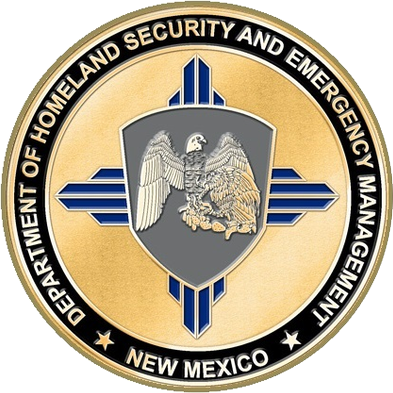EPCRA
EPCRA Overview
The Emergency Planning and Community Right-to-Know Act
EPCRA is administered by the U.S. Environmental Protection Agency (EPA) and implemented by the New Mexico Department of Homeland Security and Emergency Management (DHSEM). The purpose of this law is to encourage emergency planning efforts at the state and local levels and to increase the public’s access to information about the potential chemical hazards that may exist in their communities. The data collected is used by the Local Emergency Planning Committees (LEPC) to develop hazardous materials emergency plans to use in responding to and recovering from a release or spill of hazardous or toxic substances. These plans are reviewed and approved by the State Emergency Response Commission (SERC). All of the chemical data collected, as well as the plans, are available for the general public to review upon request. Please click here for the EPCRA Request for Information Form and instructions.
What Does EPCRA Cover? EPCRA Has four major provisions:
Emergency Planning (Section 301-303):
Section 302 Extremely Hazardous Substance (EHS) Acquisition:
Under Section 302, your facility must report to the SERC and LEPC if it has present an amount that meets or exceeds the threshold planning quantity (TPQ) of any of the EHSs. The EHSs can be found in Appendix A or B of 40 CFR Part 355 or in Appendix A of the “Title III List of Lists.” The EHSs are any of the chemicals listed under the column titled “Section 302.” Notifications are due within 60 days after EHS acquisition
Section 303 Facility Representative Designation:
Any facility subject to Section 302 must send the SERC and LEPC the name and telephone number of a contact person (facility representative) at the facility. The name of the facility representative must be kept current.
Emergency Release Notification (Section 304):
Section 304 Emergency Release Notification:
Section 304 requires releases of chemicals greater than the reportable quantity (RQ) to be reported by the facility owner or operator. There are two types of chemicals that require reporting under this section: EHSs and Comprehensive Environmental Response Compensation and Liability Act (CERCLA) hazardous substances. The RQ for both the EHSs and the CERCLA hazardous substances are found in the “Title III Consolidated List of Chemicals.” In addition, CERCLA spills must also be reported to the National Response Center at (800) 424-8802.
Notifications must be made immediately to the SERC and LEPC. Notifications to the SERC are to be made by calling DHSEM at 505-476-9635 (EOC 24/7) or 505-415-2983 (Preparedness Bureau Mon-Fri 8am-5pm). The initial emergency notification must include the following information:
1) the chemical name;
2) an indication of whether the substance is an EHS;
3) an estimate of the quantity released into the environment;
4) the time and duration of the release;
5) the medium into which the release occurred;
6) any known or anticipated acute or chronic health risks associated with the emergency and, where appropriate, advice regarding medical attention necessary for exposed individuals;
7) proper precautions, such as evacuation; and
8) the name and telephone number of a contact person.
As soon as practicable after a release which requires notification, the owner or operator of the facility must provide one or more written follow-up emergency notice(s) to the LEPC and the SERC. The written follow-up emergency notice must include:
1) information setting forth and updating the information required for the initial emergency notification;
2) actions taken to respond to and contain the release;
3) any known or anticipated acute or chronic health risks associated with the release; and
4) advice regarding medical attention necessary for exposed individuals.
Hazardous Chemical Storage Reporting Requirements (Sections 311-312):
Section 311 Safety Data Sheet (SDS) Submission:
The chemicals covered under Section 311 are: 1) any of the EHSs that meet or exceed the TPQ, or 500 pounds, at any one time, whichever is less; and 2) any of the hazardous chemicals that meet or exceed 10,000 pounds at any one time for which OSHA requires a SDS to be maintained. SDS must be submitted to the SERC, LEPC, and local fire department within 90 days after chemical’s acquisition or change in process.
This is a one-time reporting requirement; however, within 90 days of discovering significant new information on a chemical, or upon acquiring a new chemical that is covered, a facility must submit a MSDS or a list of those chemicals. A facility must submit a revised list, or an addition to the list, if the new information about that chemical changes the hazard category under which it falls, or if the facility acquires a new substance that meets or exceeds the threshold that was not included on the initial list.
Section 312 Tier II Report: due between January 1 and March 1 for previous calendar year to the SERC.
Under this section, facility must submit an inventory form of the hazardous chemicals and extremely hazardous substances (EHS) that they possess. The minimum thresholds for this reporting is 500 pounds or TPQ, whichever is less, for EHS, or the TPQ for the rest of the hazardous chemicals. For chemicals that are solids, there may be two TPQs given (e.g., 500/10,000). In these cases, the lower quantity applies for solids in powder form with particle size less than 100 microns, or if the substance is in solution or in molten form. Otherwise, the 10,000 pounds TPQ applies.
Corrections to the inventory form can be submitted at any time.
Toxic Chemical Release Inventory (Section 313)
Section 313 Toxic Release Inventory (TRI): due by July 1.
New Mexico participates in the TRI Data Exchange (TDX), so that New Mexico facilities must report TRI only to EPA. No separate report is due to the SERC. Submission of report is done on-line using the EPA web site http://www.epa.gov/tri/index.htm.
In occasions when a report or written notification is required to be submitted to the SERC, those need to be sent to the following address:
Department of Homeland Security and Emergency Management

